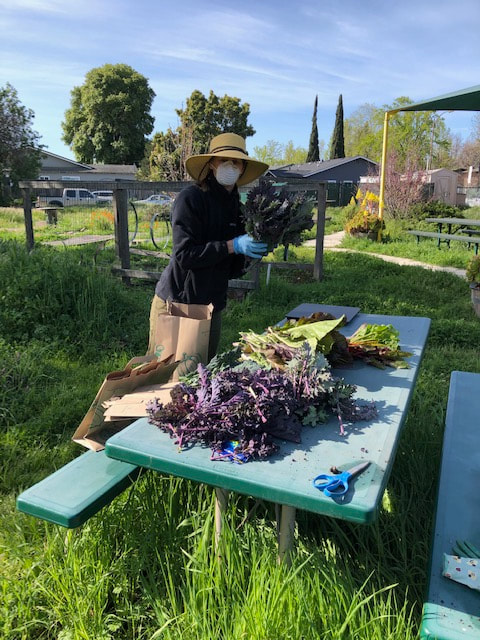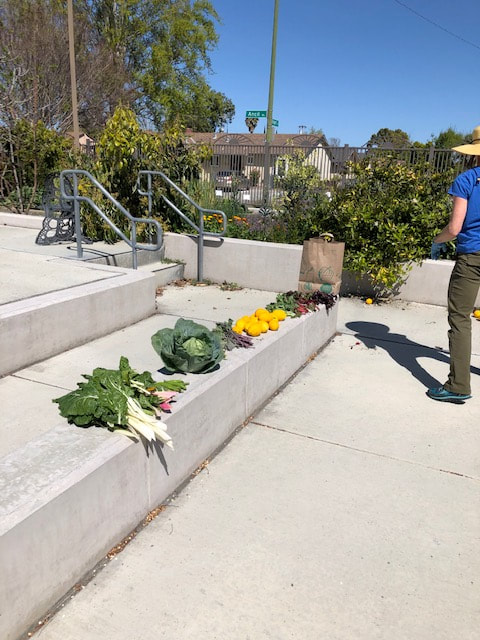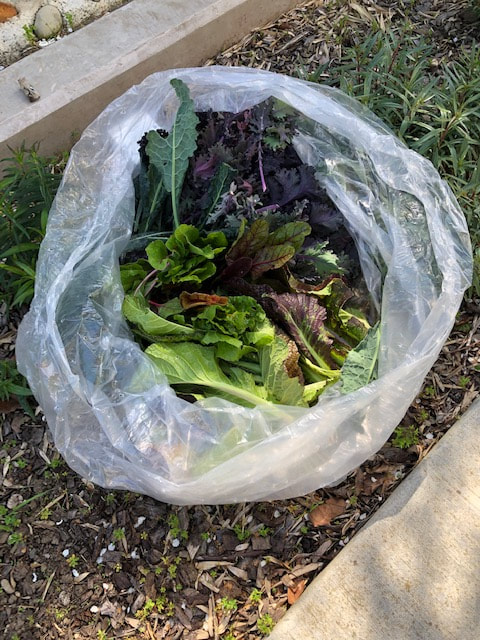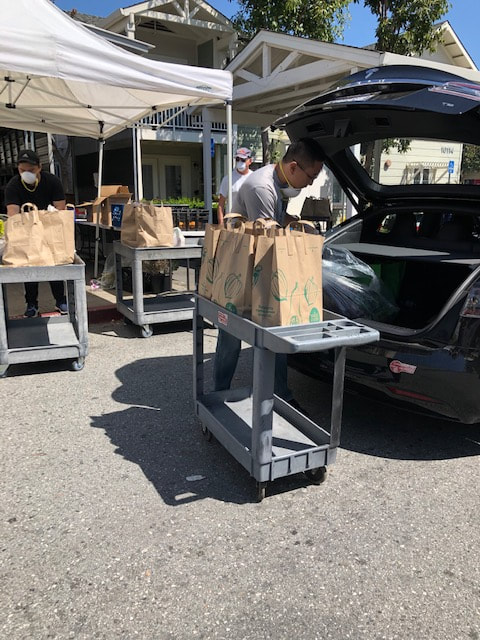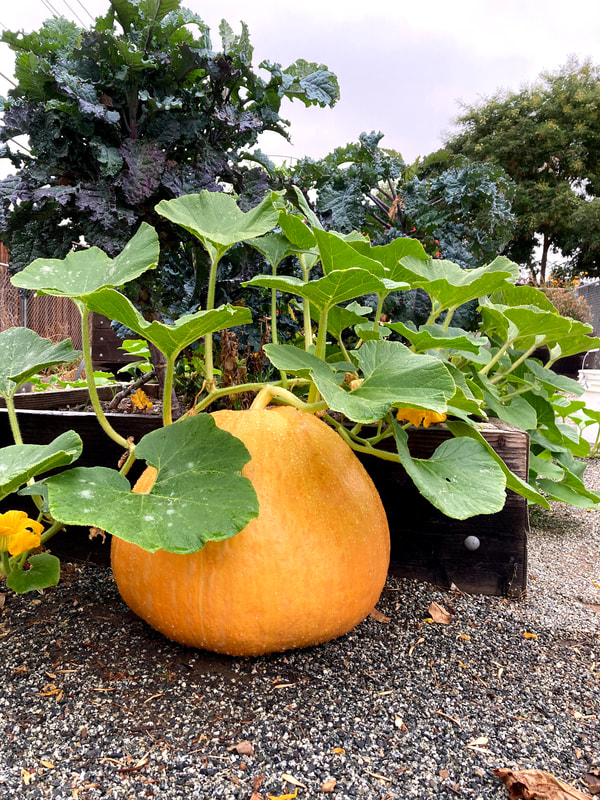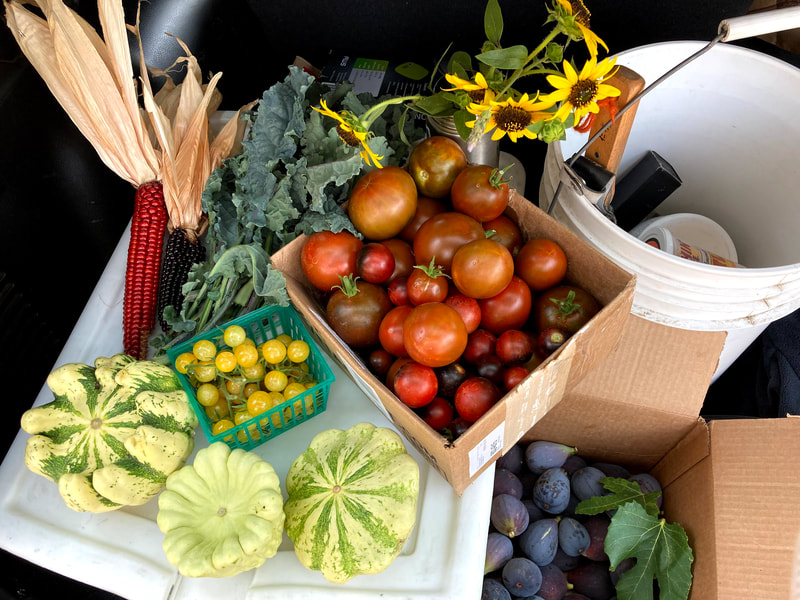Living Schoolyards Act
Living Schoolyards Act in Congress supports outdoor education nationwide! Click here for more details.
Margot G Harrigan's Retirement Remarks
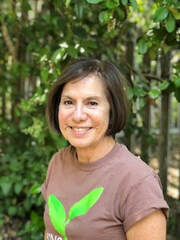
I leave with deep and boundless admiration and respect for the Living Classroom team and all that we have achieved together in five years. They believe in environmental literacy and in sharing their passion for the natural world. They embrace and embody collaboration, teamwork, inclusiveness and innovation in everything they do.
I am very proud of our accomplishments and achievements during my tenure. Since September 2018, Living Classroom:
Vicki Moore, founder of Living Classroom, will be the Acting Executive Director and will be supported by our Board in sharing responsibilities effective July 1st.
My short term plans include going to the beach, a bit of travel and reading lots of books longer than 300 pages. I will be volunteering for two organizations I am proud to support, which will keep me busy. I look forward to more time with family, friends and traveling near and far.
I am deeply appreciative of the many opportunities that being an Executive Director provided, especially the opportunity to work with people like you. Let's stay in touch! My personal email is [email protected]. My heart is filled with gratitude for the support and encouragement you have shown me - many, many thanks. Take care of each other and the planet.
What did I learn at Living Classroom in five years? A lot! A few things that are memorable:
I reacquainted myself with how hard individuals who work with children work, as I saw how the Living Classroom’s collective teams - educators, gardeners, materials managers and support staff - all worked together to assure that students and teachers had an amazing experience each and every time. And they DID - more than 4,000 times! Even with a pandemic and the onset of remote learning - this team created 21 unique lessons to deliver to students remotely - probably one of the few “silver linings” of the pandemic!
I am very proud of our accomplishments and achievements during my tenure. Since September 2018, Living Classroom:
- Taught 25,889 students in as many as 21 schools
- Led 4090 lessons
- Maintained an average of 35 gardens a year
- Harvested literally tons of produce that was either consumed or donated to local food banks.
Vicki Moore, founder of Living Classroom, will be the Acting Executive Director and will be supported by our Board in sharing responsibilities effective July 1st.
My short term plans include going to the beach, a bit of travel and reading lots of books longer than 300 pages. I will be volunteering for two organizations I am proud to support, which will keep me busy. I look forward to more time with family, friends and traveling near and far.
I am deeply appreciative of the many opportunities that being an Executive Director provided, especially the opportunity to work with people like you. Let's stay in touch! My personal email is [email protected]. My heart is filled with gratitude for the support and encouragement you have shown me - many, many thanks. Take care of each other and the planet.
What did I learn at Living Classroom in five years? A lot! A few things that are memorable:
- I learned science that I should have learned in elementary school: photosynthesis, plant adaptations, the parts of a plant…
- I learned it was possible to make vegetable soup with first graders, pretzels with second graders and to discuss hummus with 6th graders!
- I came to appreciate and enjoy worms!
- I learned about the Three Sisters crops and why they are planted together.
- I learned about asymmetry, rotational symmetry and bilateral symmetry in nature.
I reacquainted myself with how hard individuals who work with children work, as I saw how the Living Classroom’s collective teams - educators, gardeners, materials managers and support staff - all worked together to assure that students and teachers had an amazing experience each and every time. And they DID - more than 4,000 times! Even with a pandemic and the onset of remote learning - this team created 21 unique lessons to deliver to students remotely - probably one of the few “silver linings” of the pandemic!
Many Thanks to Jason!
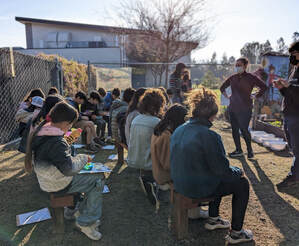
Living Classroom would like to thank Jason, a tenth grade student at Mountain View High School, for the Eagle Scout project he completed this past Fall.
The bench seating that he designed, built and installed at his former school, Imai Elementary, are now being put to good use for our lessons!
Pictured are fifth grade students sitting on the new benches and enjoying their Energy Salad in Imai's school garden.
The bench seating that he designed, built and installed at his former school, Imai Elementary, are now being put to good use for our lessons!
Pictured are fifth grade students sitting on the new benches and enjoying their Energy Salad in Imai's school garden.
Teacher Letter to her District about Living Classroom
Dear School Board Members,
As a follow up to last week’s comments, I’m writing to share my personal experiences with Living Classroom. I know firsthand what a wonderful experience Living Classroom is for children and teachers. My students always cheered when they saw it on the schedule in the morning.
Impact on teachers
Living Classroom is district-wide at Mountain View Whisman School District. Their pilot began in 2013 and it expanded to all 11 schools in a few years. Community support from the MV Educational Foundation and other grants - which our school educational foundation will also be eligible for once we start - fund the program.
Our administration required us to commit to 4 classes during the school year, but my team chose to max out the number of lessons and signed up for 9 lessons a year. We scheduled Living Classroom lessons on an easy-to-use web portal with drop down menus to select classes. We completed this during a grade level collaboration meeting at the beginning of the year.
Before lessons we needed to: 1) try to recruit 1-3 parent volunteers for each lesson and 2) provide name tags for our students (I used reusable lanyards).
For other perspectives, I asked MVWSD teachers to complete a survey. The results are here.
Family engagement
The number of recommended parents for each lesson was indicated on the sign up web portal and follow up confirmation email. I put a volunteer sign-up sheet out at Back to School Night and usually half of the slots were filled by the end of the night or by the end of the week after parents returned their volunteer availability papers. I taught at a Title I school (Theuerkauf) where working parents were often not available to volunteer during the school day. Volunteering to help during a LC lesson is attractive because it’s much less of a time commitment - just 1.5 hours per lesson - than chaperoning a whole-day field trip. We also had a few grandparent and adult sibling volunteers. It was a great chance for me to chat with family and get to know them and their kids better, building community. If we didn't have enough volunteers for a lesson, I'd email the Program Manager for MVWSD 48 hours in advance, and she'd find another docent to come or we'd plan a way to do the lesson with just the two of us running stations.
Integration with grade level standards
The Program Manager sent the lesson plan to teachers a week in advance, which I sometimes used for activities to activate prior knowledge or read aloud suggested accompanying texts. There was no expectation for us teachers to prepare for the lesson. Over the years I learned the lessons and planned to incorporate them with other disciplines. MV uses the Foss science curriculum. The module correlation is listed in the lesson plans, making it easy to teach the same standard strand with Foss materials.
After lessons, I had my students apply their LC experiences. Living Classroom and History and Social Sciences are natural tie-ins: geography and habitat, graphs and mapping, conservation and political activism. I had my students write procedural paragraphs after the “Seed to Pretzel” lesson series. I used the topic of seed dispersal for Write Tools' style color-coded 5-8 sentence paragraphs. I had students present their science writing to classmates during “publishing parties”' or post themselves reading their writing to Class Dojo portfolios for their parents to watch.
Language learner support
Before my first lesson with Living Classroom, I pulled my language learners (there were many at my Title 1 school) aside for a short mini-lesson and to preview words like "dispersal" before the “Traveling Seeds” lesson. During the lesson, I found language support was embedded and pre-teaching wasn't necessary for future lessons. Since the whole class instruction was led by LC, I focused on classroom management (not much typically required because the kids were so engaged) and individual support of language learners and other students. LC provides a new avenue for meaningful and relevant context for English language skill development.
Engaging, inquiry-based instruction
The lesson description, objective, and guiding questions are included in the lesson plan. On a Living Classroom day, skillful instructors came with fully stocked bins and prepped materials. She’d arrive 20 minutes before the lesson to set-up and meet with parent volunteers for 10-15 minutes before to describe the lesson and their support roles.
The instructor began whole class instruction by posing a question that would drive the lesson’s inquiry and give a sense of meaning and relevance. They introduced academic language and contextualizes the concepts for students in terms of their previous experiences. Then there would be hands-on engagement - often within table groups of 4 - observing samples like animal skulls, seeds, or maps and hypothesizing on why the samples differed.
Afterwards, we’d head to a rotation of inquiry-based hands-on stations. This is when you’d find my students: on the perimeter of a large tarp, piled high with top soil, raking through for living organisms and organic materials that benefit plant growth; planting, harvesting, and grinding wheat seeds to prepare them for baking pretzels (a 3-part lesson series); pouring water over sand, soil, and mulch to observe properties of planting substrates; using found objects to create a seed dispersal mechanism; learn coordinate mapping on a walkable grid by the garden and then applying the concepts to plotting the raised bed area. These are the types of experiential lessons I as a teacher most valued because 1) my students loved the active and engaging lessons outdoors 2) I did not have the bandwidth to plan or prep these types of in-depth experiential activities 3) rotating through and supporting the groups without leading instruction gave me more opportunities to connect with my students personally.
We ended the hour-long Living Classroom session with a whole class closure activity. The instructor would lead students to connect their experiences back to the lesson objective and tie back into the guiding questions.
Inclusion of special education students
I spoke with a moderate/severe special education teacher who said while at MVWSD,
"My class did not participate with Living Classroom, although we would have if invited! I believe it would have been a great inclusion opportunity- meaning connecting the students by grade level and sending an aide. For example, two SDC students would join a general education classroom for the activity. I don't think the coordinator or instructor would need to create a separate lesson or curriculum for special education students. I think this type of program is often inherently sensory friendly and engaging for all learners."
We can plan for inclusion in our schools.
Impact of gardens and green learning space
The gardens themselves add beauty to the school community. We at Theuerkauf had a huge native garden which I could walk through on the way to and from the parking lot to the classroom. It was a chance to be mindful of my surroundings and reset before or after the school day. When we decided to convert our front yard from grass to low-water native plants, it was even a place to select plants such as muhly grass, yarrow, and sticky monkeyflower to grow at home. The native gardens provide habitats for wildlife including critical pollinators such as bees, hummingbirds, and monarch butterflies. The gardens are also a shaded refuge in which our kids could play during recess.
Living Classroom will provide green learning areas to all children, including those who otherwise wouldn’t have access. We can plant the idea that we all belong in nature and can be environmentalists and scientists. The Living Classroom philosophy believes in helping our kids understand the relationship between ourselves and nature. As our children grow up, they will develop an ecological conscience and become citizens that care about and act to protect our environment. We all know the dire climate condition of our planet. With Living Classroom, our district can help prepare our future generation of leaders with education about our world and knowledge of how we can sustainably live on Earth.
Leadership
You are leaders who care about equity and serving the whole-child. I urge you to fund Living Classroom to provide green learning spaces and garden-based lessons to every child in our school district. Our school district educational foundation stands behind our initial financial commitment of $25,000 to start the program up this coming year. We also offer continued partnership with the district to fund Living Classroom in all schools in the district. We are committed to bringing and sustaining the Living Classroom program in our school district.
Thank you for your consideration. Please don’t hesitate to contact me for further discussion of this topic.
Respectfully,
Peggy
As a follow up to last week’s comments, I’m writing to share my personal experiences with Living Classroom. I know firsthand what a wonderful experience Living Classroom is for children and teachers. My students always cheered when they saw it on the schedule in the morning.
Impact on teachers
Living Classroom is district-wide at Mountain View Whisman School District. Their pilot began in 2013 and it expanded to all 11 schools in a few years. Community support from the MV Educational Foundation and other grants - which our school educational foundation will also be eligible for once we start - fund the program.
Our administration required us to commit to 4 classes during the school year, but my team chose to max out the number of lessons and signed up for 9 lessons a year. We scheduled Living Classroom lessons on an easy-to-use web portal with drop down menus to select classes. We completed this during a grade level collaboration meeting at the beginning of the year.
Before lessons we needed to: 1) try to recruit 1-3 parent volunteers for each lesson and 2) provide name tags for our students (I used reusable lanyards).
For other perspectives, I asked MVWSD teachers to complete a survey. The results are here.
Family engagement
The number of recommended parents for each lesson was indicated on the sign up web portal and follow up confirmation email. I put a volunteer sign-up sheet out at Back to School Night and usually half of the slots were filled by the end of the night or by the end of the week after parents returned their volunteer availability papers. I taught at a Title I school (Theuerkauf) where working parents were often not available to volunteer during the school day. Volunteering to help during a LC lesson is attractive because it’s much less of a time commitment - just 1.5 hours per lesson - than chaperoning a whole-day field trip. We also had a few grandparent and adult sibling volunteers. It was a great chance for me to chat with family and get to know them and their kids better, building community. If we didn't have enough volunteers for a lesson, I'd email the Program Manager for MVWSD 48 hours in advance, and she'd find another docent to come or we'd plan a way to do the lesson with just the two of us running stations.
Integration with grade level standards
The Program Manager sent the lesson plan to teachers a week in advance, which I sometimes used for activities to activate prior knowledge or read aloud suggested accompanying texts. There was no expectation for us teachers to prepare for the lesson. Over the years I learned the lessons and planned to incorporate them with other disciplines. MV uses the Foss science curriculum. The module correlation is listed in the lesson plans, making it easy to teach the same standard strand with Foss materials.
After lessons, I had my students apply their LC experiences. Living Classroom and History and Social Sciences are natural tie-ins: geography and habitat, graphs and mapping, conservation and political activism. I had my students write procedural paragraphs after the “Seed to Pretzel” lesson series. I used the topic of seed dispersal for Write Tools' style color-coded 5-8 sentence paragraphs. I had students present their science writing to classmates during “publishing parties”' or post themselves reading their writing to Class Dojo portfolios for their parents to watch.
Language learner support
Before my first lesson with Living Classroom, I pulled my language learners (there were many at my Title 1 school) aside for a short mini-lesson and to preview words like "dispersal" before the “Traveling Seeds” lesson. During the lesson, I found language support was embedded and pre-teaching wasn't necessary for future lessons. Since the whole class instruction was led by LC, I focused on classroom management (not much typically required because the kids were so engaged) and individual support of language learners and other students. LC provides a new avenue for meaningful and relevant context for English language skill development.
Engaging, inquiry-based instruction
The lesson description, objective, and guiding questions are included in the lesson plan. On a Living Classroom day, skillful instructors came with fully stocked bins and prepped materials. She’d arrive 20 minutes before the lesson to set-up and meet with parent volunteers for 10-15 minutes before to describe the lesson and their support roles.
The instructor began whole class instruction by posing a question that would drive the lesson’s inquiry and give a sense of meaning and relevance. They introduced academic language and contextualizes the concepts for students in terms of their previous experiences. Then there would be hands-on engagement - often within table groups of 4 - observing samples like animal skulls, seeds, or maps and hypothesizing on why the samples differed.
Afterwards, we’d head to a rotation of inquiry-based hands-on stations. This is when you’d find my students: on the perimeter of a large tarp, piled high with top soil, raking through for living organisms and organic materials that benefit plant growth; planting, harvesting, and grinding wheat seeds to prepare them for baking pretzels (a 3-part lesson series); pouring water over sand, soil, and mulch to observe properties of planting substrates; using found objects to create a seed dispersal mechanism; learn coordinate mapping on a walkable grid by the garden and then applying the concepts to plotting the raised bed area. These are the types of experiential lessons I as a teacher most valued because 1) my students loved the active and engaging lessons outdoors 2) I did not have the bandwidth to plan or prep these types of in-depth experiential activities 3) rotating through and supporting the groups without leading instruction gave me more opportunities to connect with my students personally.
We ended the hour-long Living Classroom session with a whole class closure activity. The instructor would lead students to connect their experiences back to the lesson objective and tie back into the guiding questions.
Inclusion of special education students
I spoke with a moderate/severe special education teacher who said while at MVWSD,
"My class did not participate with Living Classroom, although we would have if invited! I believe it would have been a great inclusion opportunity- meaning connecting the students by grade level and sending an aide. For example, two SDC students would join a general education classroom for the activity. I don't think the coordinator or instructor would need to create a separate lesson or curriculum for special education students. I think this type of program is often inherently sensory friendly and engaging for all learners."
We can plan for inclusion in our schools.
Impact of gardens and green learning space
The gardens themselves add beauty to the school community. We at Theuerkauf had a huge native garden which I could walk through on the way to and from the parking lot to the classroom. It was a chance to be mindful of my surroundings and reset before or after the school day. When we decided to convert our front yard from grass to low-water native plants, it was even a place to select plants such as muhly grass, yarrow, and sticky monkeyflower to grow at home. The native gardens provide habitats for wildlife including critical pollinators such as bees, hummingbirds, and monarch butterflies. The gardens are also a shaded refuge in which our kids could play during recess.
Living Classroom will provide green learning areas to all children, including those who otherwise wouldn’t have access. We can plant the idea that we all belong in nature and can be environmentalists and scientists. The Living Classroom philosophy believes in helping our kids understand the relationship between ourselves and nature. As our children grow up, they will develop an ecological conscience and become citizens that care about and act to protect our environment. We all know the dire climate condition of our planet. With Living Classroom, our district can help prepare our future generation of leaders with education about our world and knowledge of how we can sustainably live on Earth.
Leadership
You are leaders who care about equity and serving the whole-child. I urge you to fund Living Classroom to provide green learning spaces and garden-based lessons to every child in our school district. Our school district educational foundation stands behind our initial financial commitment of $25,000 to start the program up this coming year. We also offer continued partnership with the district to fund Living Classroom in all schools in the district. We are committed to bringing and sustaining the Living Classroom program in our school district.
Thank you for your consideration. Please don’t hesitate to contact me for further discussion of this topic.
Respectfully,
Peggy
Living Classroom Donates to the CommunityLiving Classroom gardens have donated over 1,000 pounds of produce to local community service agencies since the shelter in place order was issued in March 2020. West Valley Community Services greatly appreciates the donations.
One community member has already reached out to our Executive Director thanking her for the Living Classroom Donation, "It is so thoughtful of you to think of us and our community who are going hungry in this pandemic. Thank you for donating to us. That is so very much appreciated." |
Subscribe to Our NewsletterNewsletter Archive
|

